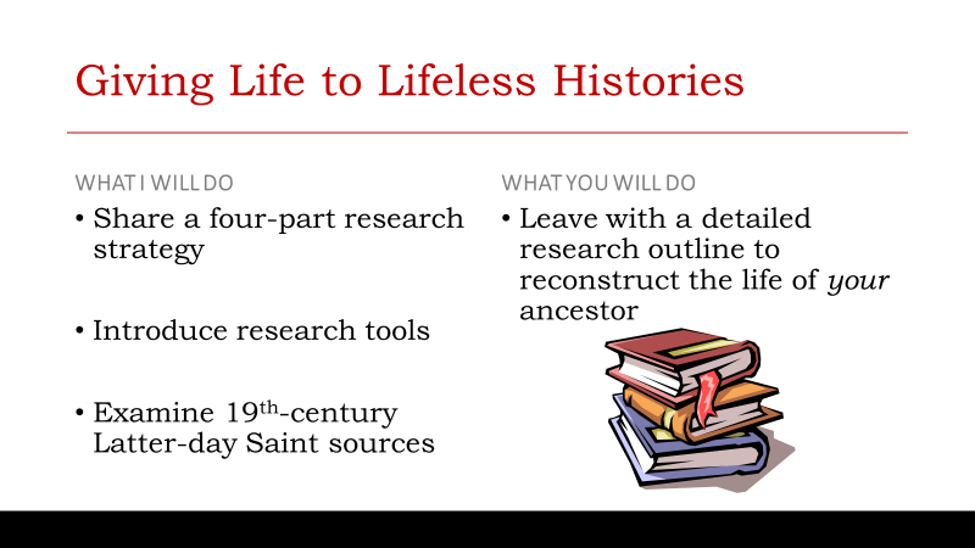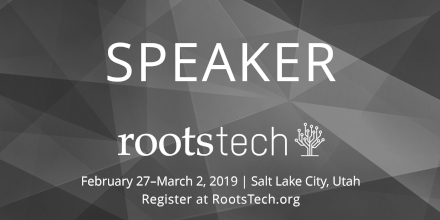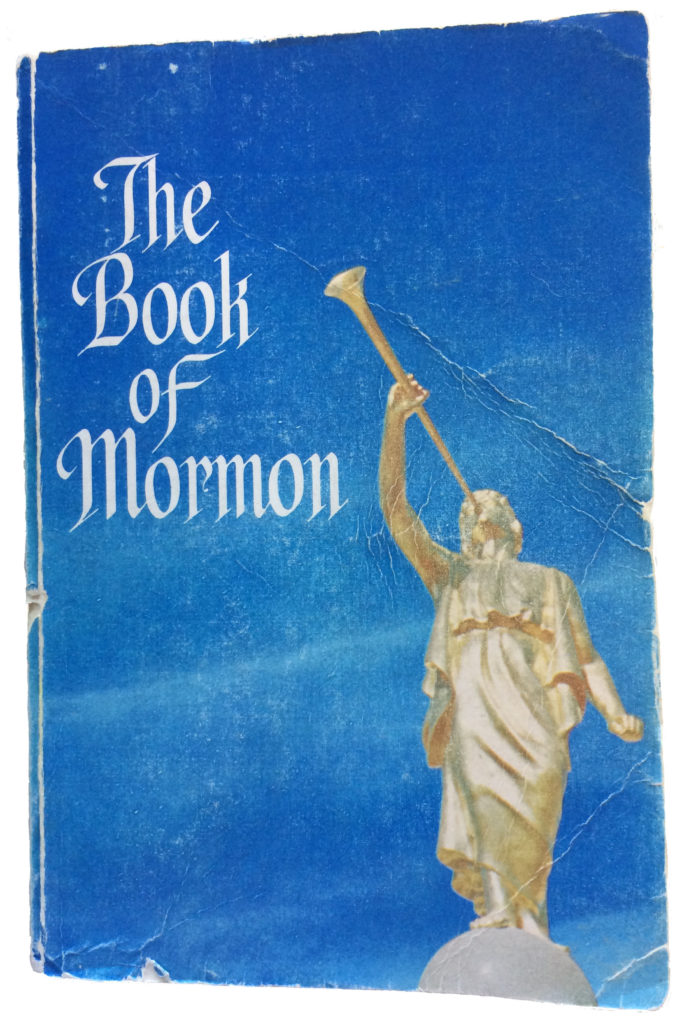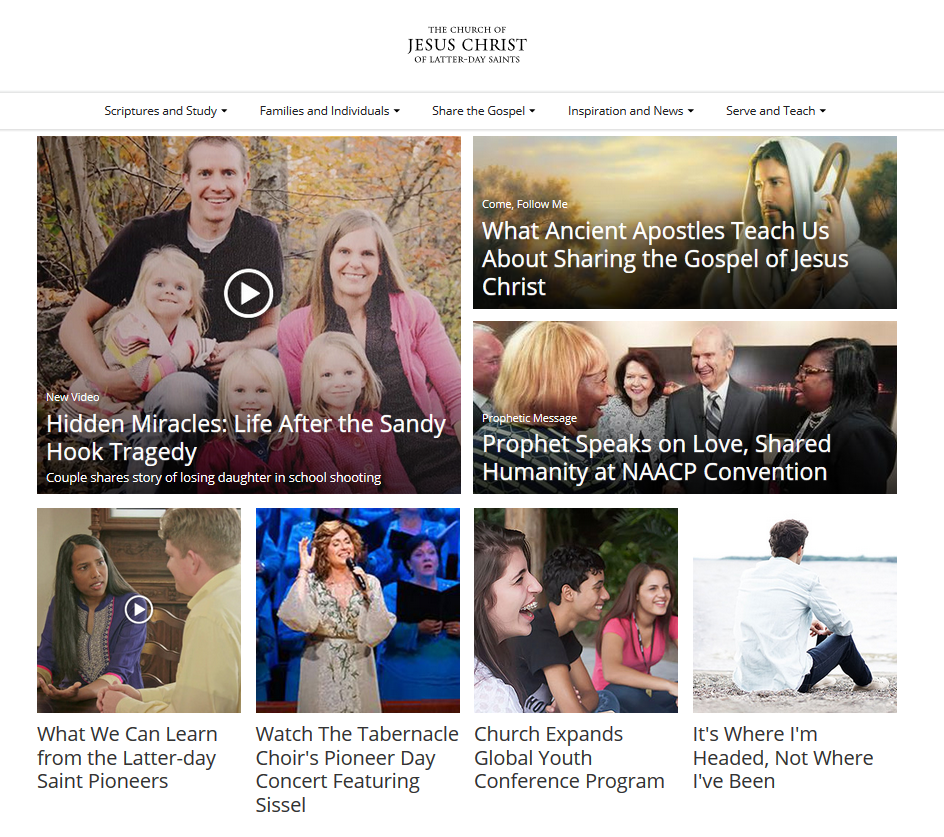Giving Life to Lifeless Latter-day Saint Histories
Do you have a 19th-Century Latter-day Saint ancestor who did not keep a journal? Learn about strategies and sources for researching and writing to turn dates and places into rich stories and experiences.

1. Begin with Existing Records and Rumors
- Gather everything possible
- Select accurate information using an outline of events and a list of acquaintances
2. Verify, Verify, Verify
- Missionary service (Use your FamilySearch login)
- Known by Joseph Smith (Use your FamilySearch login)
- Relief Society records (Use your FamilySearch login)
- Black Latter-day Saints
- Church History Library Catalog
- Residence in Nauvoo, Illinois
- Ocean migration
- Overland pioneer travel (Use your FamilySearch login)
- Utah newspapers
- Biographical sketches
So you think your ancestor was Joseph Smith’s bodyguard?
- Members of the Nauvoo Legion
- Members of the Nauvoo Police force on 29 Dec 1843 and Mar-Dec 1843
3. Flesh Out with Original Sources
- Pioneer database
- Church periodicals
- Index to periodicals #1: Early Church Information File
- Index to periodicals #2: Journal History of the Church
4. Fill Out with Contextual Information
- Mormon Places
- Global Histories
- Searchable bibliography of Studies in Mormon History
Recommended Histories
General Church History
- Saints: The Story of the Church of Jesus Christ in the Latter Days, 4 vols. (2018-)
- The Story of the Latter-day Saints, by James B. Allen and Glen M. Leonard (1992)
- Mapping Mormonism: An Atlas of Latter-day Saint History, ed. Brandon S. Plewe (2014)
Early Church History
- Hearken, O Ye People: The Ohio Setting of Joseph Smith’s Ohio Revelations, by Mark L. Staker (2010)
- Fire and Sword: A History of the Latter-day Saints in Northern Missouri, 1836-1839, by Leland H. Gentry and Todd M. Compton (2011)
- A City of Refuge: Quincy, Illinois, eds. Susan Easton Black and Richard E Bennett (2000)
- Nauvoo: A Place of Peace, A People of Promise, by Glen M. Leonard (2002)
Early Converts and Missionaries
- Men with a Mission: The Quorum of the Twelve Apostles in the British Isles. S, by Allen, James B., Ronald K. Esplin, and David J. Whittaker (1992)
- Mormonism and the Making of a British Zion, by Matthew L. Rasmussen (2016)
- Homeward to Zion: The Mormon Migration from Scandinavia, by William Mulder (2000)
- Unto the Islands of the Sea: A History of the Islands of the Sea in the Pacific, by R. Lanier Britsch (1986)
Pioneer-Era History
- Mormons at the Missouri 1846-1852: “And Should We Die,” by Richard E. Bennett (1987)
- We’ll Find the Place: The Mormon Exodus, 1846-1848, by Richard E. Bennett (1997)
- Handcarts to Zion: The Story of a Unique Western Migration, 1856-1860, by Leroy R. Hafen and Ann W. Hafen (1992)
- A House Full of Females: Plural Marriage and Women’s Rights in Early Mormonism, 1835-1870, by Laurel Thatcher Ulrich (2017)
Additional information and resources are available on the Church History Library’s website.

With the recent publication of my complete analysis in BYU Studies, I thought I’d answer the ten most common questions I’ve received about Elvis Presley and the Book of Mormon. (Page numbers in parenthesis are from the article.)

Q1. Did Elvis Presley write in this copy of the Book of Mormon?
A. No. The handwriting is clearly forged and the provenance is highly improbable.
Elvis Presley did not write in the Book of Mormon held by the Church History Library. The story of the book’s provenance—its being given to Elvis fourteen days before his death and being read and digested from first page to last—does not fit within the constraints of a period in which he hosted his daughter, prepared for a tour, and responded to an exposé about his prescription drug abuse and erratic behavior. Further, analysis of the handwriting in the Book of Mormon volume—a signature and three dozen smoothly written annotations—reveals dramatic departures from Presley’s authentic handwriting as well as differences in the style of his marginal annotation. After nearly three decades of uncertainty, this investigation can turn on the popular culture public announcement system to declare without hesitation: “Ladies and gentlemen, Elvis has left the library.”
(page 72)
Q2. Didn’t the Osmonds say that Elvis wrote in this book?
A. Yes. Multiple times. They are one of the many victims of this forgery. I personally shared the findings with Alan Osmond.
When I shared the findings of forgery with Alan Osmond, he was both surprised and saddened . . . . Though clearly a victim of the forger, Alan quickly recognized the strength of the evidence and said, “The Church is true, and it doesn’t need Elvis’s name. I am thankful that you have checked this out. We want to put closure on this.” To me, Alan provides an inspiring example that it is okay to change one’s view when new evidence is uncovered.
(page 75)
Q3. Did Elvis ever read from the Book of Mormon?
A. Probably. He was an avid reader, he was interested in religions and philosophies, and he discussed Latter-day Saint beliefs with professional acquaintances.
Both Ed Parker and the Osmonds gave copies of the Book of Mormon to Elvis and reported discussing the text with him. To date, every claim of an active full-time missionary teaching Elvis has turned out to be false—the missionary did not serve in the right mission, or served in the right mission at the wrong time, or the missionary name did not even exist . . . . Parker provides an important check against overspeculation: Elvis “often told people what he thought they wanted to hear; not in attempt to be dishonest, but simply in an attempt to be accommodating.”
(page 76)
Q4. Are there other copies of the Book of Mormon connected to Elvis?
A. Yes. A couple of missionaries gave him copies in Hawaii, and many fans sent him printed materials.
One of Presley’s secretaries reported that “Mormons sent literature and books to Elvis, Jehovah’s Witnesses mailed issues of the Watchtower to him, and he received copies of the Living Bible and dozens of other Bibles in the mail from people who asked that he read them. (When stories circulated that he was losing his eyesight, someone sent him a Bible in braille.)”
(pages 69-70)
Q5. Do we know what Elvis thought about the Book of Mormon?
A. No. There are no surviving records that indicate his thoughts. And one should not leap to inferences.
One lesson to learn from this forgery is not to draw conclusions that reach beyond the evidence. For example, just because someone gave Elvis a Book of Mormon does not mean that he read it; and just because he read a copy (or marked it) does not mean that he believed it and desired baptism . . . . Thus, when a video published by the Graceland Archives reveals a paperback copy of the Book of Mormon among Elvis’s books, what does it mean? It means simply that a copy made it into his collection. Are there annotations? Yes, but not in Elvis’s handwriting (most likely by a missionary). Did Elvis read it? We can’t be sure. Did he believe it? The book won’t reveal that.
(pages 75-76)
Q6. So why does this finding matter?
A. This is the only copy that claimed to report what Elvis thought about the book. This hoax gave celebrity-seeking Saints just what they hoped.
Forgeries are often accepted because they provide something that people already want; in this case, the story of a changed heart, the conversion of a celebrity, and a testimony of the Church.
(page 69)
Q7. Is it really a hoax?
A. Yes. The handwriting was very poorly imitated, and the messages in the margins are laughable. Someone was clearly messing with us.
For example, the forger underlined passages about excessive drunkenness (2 Ne. 15:11) and King Noah’s whoredoms (Mosiah 11:2). Beneath a photograph of an ancient gold tablet, the smooth-handed forger wrote, “gold records—real ones.” Underlining “Thou shalt have no other God before me” (Mosiah 12:35), the forger wrote, “Fans = Not me either.” But the forger also wanted readers to see a change in Elvis’s heart. Underlining Alma’s warning to his sexually promiscuous son Corianton about unpardonable sins (Alma 39:6), the forger dialed up two ampersand I’s to write the book’s longest annotation: “I could never deny that which I know in my heart to be true.” Yes, there was still hope for Elvis. Next to the underlined words “They were desirous to be baptized” (Mosiah 21:35), the forger wrote “me too.” But these forged desires would not come to pass, as the forger suggested that Elvis seemed to know all too well. Next to the underlined words “And now I go unto the father” (3 Ne. 18:35), the forger wrote “me too.” If this imagined Elvis had a premonition of his own imminent death, he also found hope for the future in the most widely quoted forged annotation—beneath an underlined warning from Mormon that “awful is the wickedness to suppose that God saveth one child because of baptism” (Moro. 8:16), the forger wrote, “My Lisa needs this church. She’s only 9. Help her for me.” The annotations in this volume are fabrications manufactured to deceive.
(page 69)
Q8. Who did it?
A. I don’t know.
Unfortunately, it is easier to disprove the writing of a single individual than it is to identify the writing of one of potentially millions of living persons. One might look to the handwriting of the obsessive superfan who followed Elvis across the country and back, but . . . the evidence in the book does not suggest that the “quiet fan” became an open forger.
(page 72)
Q9. Why didn’t anyone report this earlier?
A. Today there are better histories of Elvis available, and more samples of his authentic handwriting.
As I examined the volume, the annotations on its pages immediately raised more questions than answers. Internal records revealed that others had likewise questioned the book’s authenticity, as early as 1991 and as recently as 2008. My research accelerated, drawing on a host of recently published works that document Elvis’s life and activities more clearly than ever before. The passage of time has introduced more authentic samples of Presley’s handwriting into the market, as well as more forgeries to be identified by collectors, dealers, and auction houses.
(page 53)
Q10. How can I learn more?
A. A summary of the evidence has been published in the Church News and on lds.org. The complete details are in the December 2018 issue of BYU Studies.
Bonus. Anything else to share from your research?
A. My favorite real connection between Elvis and the Church is that he spent a week at the newly opened Polynesian Cultural Center filming Paradise, Hawaiian Style (1966).
The center had opened in 1963 and is featured twice on screen—first as the main character (Elvis) flies his helicopter over the PCC, lands in the Tongan village, and rides a canoe through all of the villages while singing; later, as the film ends with Elvis singing a reprise of two songs from the film on the stage of what is now part of the Hale Aloha theater.
(page 74)
In Real vs. Rumor I share a variety of interesting reactions from people to these findings of forgery. Further, I use this forgery to illustrate how developing good thinking skills can help protect us from being faked (see pp. 136-137).
My 9,000-word analysis of the forged Elvis Presley annotations in a Book of Mormon held by the Church History Library has been published in BYU Studies Quarterly. The journal’s website describes the piece as follows:
In 1989, a copy of the Book of Mormon was donated to The Church of Jesus Christ of Latter-day Saints containing, purportedly, marginal annotations made by Elvis Presley. Over the next several years, various speakers, newspaper columnists, and even a documentary film producer made claims that Elvis really had made these markings. The author of this article, who is director of the Church History Library, conducted an in-depth analysis of the book and its markings. He worked with Elvis Presley handwriting authenticators and studied the final weeks of Elvis’s life. His analysis concluded that none of the annotations in the book came from Elvis, nor did he likely have time to read the book between the time it was given to him and his death. The evidence presented in this article shows that this story deserves to be discarded.
Download the entire article at the BYU Studies website.
Citation: Keith A. Erekson, “Elvis Has Left the Library: Identifying Forged Annotations in a Book of Mormon,” BYU Studies Quarterly 57, no. 4 (2018): 51–77.
This article was published online in the Church News on November 14, 2018, and a notice appeared the same day in the Deseret News. The story ran in the print version of the Church News on November 18 (pages 18-19) and was posted on lds.org on November 20.
Elvis Presley’s copy of the Book of Mormon ain’t nothin’ but a forgery, Church history experts say
By Keith A. Erekson, Church History Library Director
Published 14 Nov 2018 8:46 am
For almost 30 years, a copy of the Book of Mormon has been preserved in the historical collections of The Church of Jesus Christ of Latter-day Saints. The book was published in 1976 with a soft, light blue cover featuring a golden Angel Moroni. Within the book there are handwritten markings on nearly one of every six pages — the majority are underlining or curved brackets, but three dozen of the pages contain handwritten words. The first page contains the signature “E. A. Presley” and on the last page (in the index) was written, “Father, I want more! I need more now. Help me!” The content and placement of the annotations suggest that Elvis Presley read this copy of the Book of Mormon from cover to cover.
The idea of Elvis Presley cherishing the Book of Mormon has captured the popular imagination of Latter-day Saints. The story of this book has been told by fireside speakers, classroom teachers, newspaper columnists, and an independent filmmaker. And the story continues to circulate throughout the market for “uplifting” books and social media.
However, after carefully analyzing the historical opportunities for Presley to have read this volume and the handwriting throughout its pages, I affirm that Elvis Presley did not write in this Book of Mormon. A detailed presentation of the analysis with photographic evidence will be published in a forthcoming issue of BYU Studies, but my findings about the book’s history, its forged signature, and its forged annotations are summarized here.
The book’s donor claimed to have given the book to Elvis Presley on Aug. 2, 1977. He died 14 days later, and the book was allegedly returned to the donor who shared it with a few people before it was transferred to the Church in 1989. The last two weeks of Elvis’ life were very busy. His 9-year-old daughter, Lisa Marie, had arrived on July 31 and he entertained her by renting out a local amusement park, screening several films, and spending an evening visiting the family of his then-current girlfriend. The day of his death was supposed to be the day he departed on tour, so much of those two weeks were spent reviewing plans and details, avoiding and reluctantly starting a liquid diet, and playing racquetball once. And, Elvis also reeled from the Aug. 6 publication of a devastating exposé of his prescription drug abuse and violent behavior. It is very unlikely that Elvis read and pondered nearly 600 pages of scripture during these 14 event-filled days.
The signature on the first page of the book is a clear forgery. Elvis signed his full name for autographs, but he did sign with just his initials on formal documents. Despite a general resemblance to his signature, significant differences appear in nearly every letter, the most dramatic being that the “P” is connected to “resley,” a closed-bottomed “s,” and the omission or serious misformation of the second “e” in Presley.
Whatever effort the forger put into making the signature look authentic was not spent on the rest of the annotations. Elvis’s authentic handwriting was erratic, jerky, and childish-looking — and grew worse over time due to stress and drug abuse. He was, in fact, a reader and an annotator of books, underlining text and writing in the margins in printed block letters. In contrast, the handwriting in this volume is cursive script and so smooth and mature that it is clearly forged.
Experts in authenticating Elvis Presley’s handwriting corroborate these findings. Music industry autograph authenticator Roger Epperson wrote: “In my opinion this is not written or signed by Elvis. The signature has some similarities to an authentic signature, but the writing is not really even close.” Rich Consola, owner of Elvis Presley Authentication, concluded: “After reviewing the signature of Elvis Presley and all the writing in this book, it is my opinion that NONE of the writing and the signature are that of Elvis Presley. To this end I am very certain.”
Elvis Presley did not write in the Book of Mormon now held by the Church History Library. Annotations suggesting that Elvis wanted to be baptized, that he believed his daughter needed the Church, and that he suspected his death was imminent are fabrications manufactured to deceive. Forgeries are often accepted because they provide something that people already want; in this case, a story of the conversion of a celebrity.
Did Elvis have any verifiable connections to the Church? Yes. He spent a week at the Polynesian Cultural Center filming the movie “Paradise, Hawaiian Style.” He was also acquainted with the Osmond family, exchanging gifts and sharing the same drummer and jumpsuit designer in Las Vegas. Elvis’s best-documented Latter-day Saint friend was his karate instructor and later bodyguard, Ed Parker.
What about those who felt inspired by a story that now turns out to be false? One lesson to learn is to seek corroboration before retelling a story. Errors arose in the repeated tellings of this story — that Elvis underlined “king” throughout, that he wished “Priscilla” would read it, or that he wrote “There is only one King.” The last two errors originated in a book marketed to Latter-day Saint readers as a “Mormon bathroom reader” — providing pungent reminders that you should judge a book by its title and that you get what you pay for. If you build the strength of your conversion on the stories of celebrities, then you face the possibility of later getting “All Shook Up.”
Ladies and gentlemen, Elvis has left the library.
The Saints sacrifice to build the Kirtland Temple. The first Twelve Apostles of the Restoration are chosen by the three witnesses. Joseph Smith and his brother William resolve a difficult personal conflict. Keith Erekson, Ph.D. Historian and Director of the Church History Library, shares his insights on these important events.
Tags
Access Policy Analogies Angel Moroni Archives & libraries Awards Black history Careers in History Church History Library Church History Speaking Come Follow Me Commemoration Conspiracy Theories Contingent Citizens Databases Elvis Presley Forgery Everybody's History Family History & Genealogy First Vision Foundations of Faith Genealogy Speaking History Skills History teaching & learning Hoaxes and History 2019 How History Works In the Church News Kirtland Temple Lincoln Making Sense of Your Patriarchal Blessing Missionaries Mormon studies Mormon Women's History Mother's Day Patriarchal Blessings Pioneers Politics Primary sources Questions and Answers RealvsRumor Saints Saints (narrative history) Sensible History Stories Texas social studies UTEP Centennial WitnessesDisclaimer
The views expressed here are the opinions of Keith A. Erekson and do not necessarily reflect the views of the Church History Department or The Church of Jesus Christ of Latter-day Saints.



